Circular Economy in the Context of Food Losses and Waste
Abstract
:1. Introduction
2. Literature Review
2.1. The Essence and Assumptions of the Circular Economy Concept
- (1)
- Biological streams in which nontoxic materials are cascaded and then returned to the biosphere for the restoration of natural capital;
- (2)
- Technical streams where the materials used are returned to the economic system, either through repair and restoration, or—ultimately—recycled [26].
- (1)
- Optimizing the use of resources and energy throughout their life cycle;
- (2)
- Maintenance of products, ingredients, and materials in the long term, assuming the highest possible level of their utility and value;
- (3)
- Passing materials through the system as many times as possible due to their cascading use in a variety of applications;
- (4)
- Use of clean materials to improve the quality of their reuse.
2.2. Circular Economy Indicators
- (a)
- Scope 0: the indicators measure physical properties from the technological cycles without LCT approach, e.g., recycling rate [38].
- (b)
- Scope 1: the indicators measure physical properties from the technological cycles with full or partial LCT approach, e.g., the indicator reusability/recyclability/recoverability (RRR) in terms of mass includes the potential rate to reuse (products and components), recycle (materials), and recover (energy) [39].
- (c)
- Scope 2: the indicators measure the effects (burdens/benefits) from technological cycles regarding environmental, economic, and/or social concerns in a cause-and-effect chain modeling, e.g., RRR benefit rate (RRR in terms of environmental effects) [40].
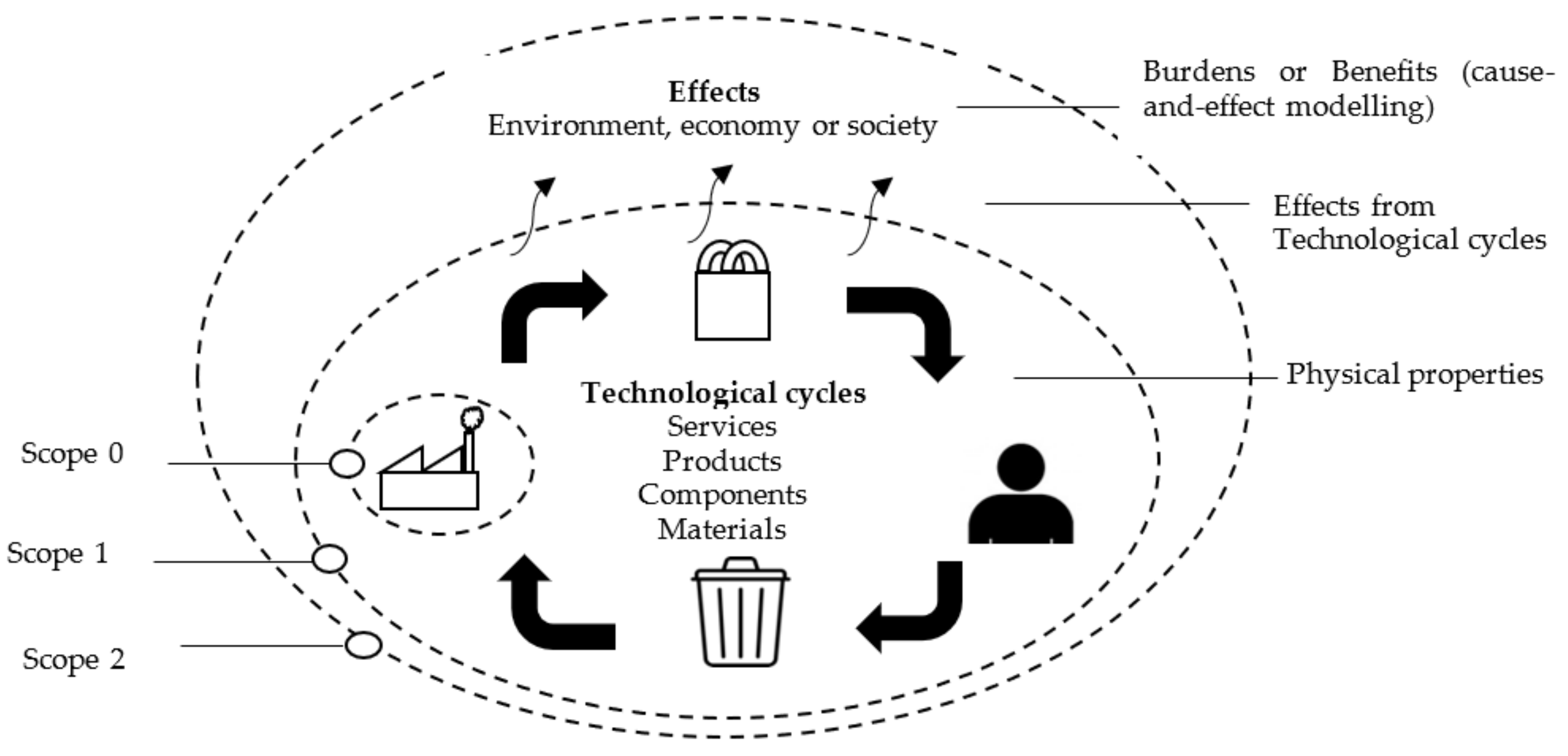
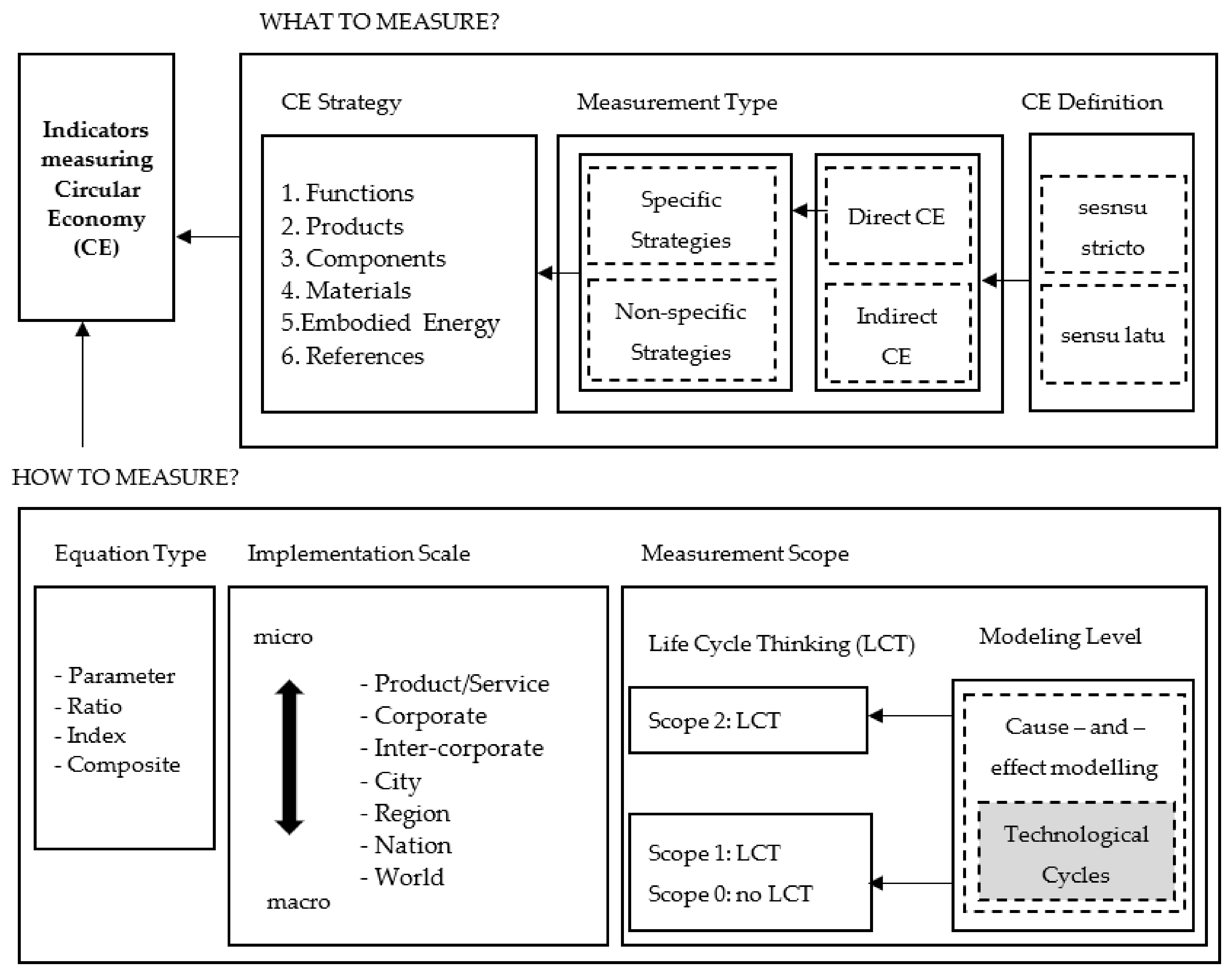
2.3. The Problem of Wasting Food
3. Materials and Methods
3.1. Study Design—The Choice of the Research Method and Study Area
3.2. Survey Questionnaire as a Research Tool
3.3. Research Sample
3.4. Data Analysis
4. Results and Discussion
4.1. Preliminary Research Results as a Background for Further Analyses
4.2. Cluster Analysis in Relation to Consumer Declarations of Throwing or Not Throwing Food Away
4.3. Analysis of the Impact of Selected Variables Grouping “Gender” and “Place of Residence” on the Attitudes and Declarations of Respondents in the Aspect of Food Waste
4.4. Analysis of the Causes of Food Waste in Terms of Gender and Place of Residence
5. Conclusions
- The respondents declare that food is thrown away rarely or very rarely, which may indicate positive attitudes of consumers towards the studied phenomenon. The obtained results refer to both women and men.
- The analysis of the correspondence made it possible to distinguish four groups of respondents, with a clear structure of indicators: (A1)—men living in smaller cities and towns, who admit that they rather waste food; (A2)—women living in rural areas and large cities, who declare that they do not throw away food; (A3)—men living in rural areas, who definitely waste food; and (A4)—women living in medium-sized cities and men from large urban agglomerations who admitted that they sometimes suffer from food waste.
- Gender seems to be the primary sociodemographic variable that potentially influences the intention to reduce food waste—women tend to try not to waste food and care about the proper management of purchases and the consumption of food products; men, on the other hand, more or less admit that they are wasting food.
- Place of residence is another grouping variable that seems to be also important—it can determine attitudes and, thus, influence various behaviors related to wasting food.
- The main reason why food is wasted among the respondents is that the food has broken (mold is visible and rancid smell), but a common reason is also the fact that the best-before date has expired; it was noticed especially by women living in smaller cities (100–300 thousand inhabitants) and men living in rural areas.
- The obtained results indicate relatively positive attitudes and a relatively high level of awareness of Polish consumers in the aspect of food waste. Nevertheless, the level of food waste in Poland is still very high. The resulting discrepancy may result from the difference between the declared and actual attitudes and behaviors of the respondents.
Author Contributions
Funding
Institutional Review Board Statement
Informed Consent Statement
Data Availability Statement
Conflicts of Interest
References
- Schanes, K.; Dobernig, K.; Gözet, B. Food Waste Matters-A Systematic Review of Household Food Waste Practices and Their Policy Implications. J. Clean. Prod. 2018, 182, 978–991. [Google Scholar] [CrossRef]
- Edjabou, M.E.; Petersen, C.; Scheutz, C.; Astrup, T.F. Food Waste from Danish Households: Generation and Composition. Waste Manag. 2016, 52, 256–268. [Google Scholar] [CrossRef] [PubMed]
- Roodhuyzen, D.M.; Luning, P.A.; Fogliano, V.; Steenbekkers, L.P.A. Putting Together the Puzzle of Consumer Food Waste: Towards an Integral Perspective. Trends Food Sci. Technol. 2017, 68, 37–50. [Google Scholar] [CrossRef]
- Qian, K.; Javadi, F.; Hiramatsu, M. Influence of the COVID-19 Pandemic on Household Food Waste Behavior in Japan. Sustainability 2020, 12, 9942. [Google Scholar] [CrossRef]
- Ponis, S.T.; Papanikolaou, P.-A.; Katimertzoglou, P.; Ntalla, A.C.; Xenos, K.I. Household Food Waste in Greece: A Questionnaire Survey. J. Clean. Prod. 2017, 149, 1268–1277. [Google Scholar] [CrossRef]
- Bravi, L.; Francioni, B.; Murmura, F.; Savelli, E. Factors Affecting Household Food Waste among Young Consumers and Actions to Prevent It. A Comparison among UK, Spain and Italy. Resour. Conserv. Recycl. 2020, 153, 104586. [Google Scholar] [CrossRef]
- Blomsma, F.; Tennant, M.; Ozaki, R. Making Sense of Circular Economy: Understanding the Progression from Idea to Action. Bus. Strategy Environ. 2022, 1–26. [Google Scholar] [CrossRef]
- Demestichas, K.; Daskalakis, E. Information and Communication Technology Solutions for the Circular Economy. Sustainability 2020, 12, 7272. [Google Scholar] [CrossRef]
- Barbaritano, M.; Bravi, L.; Savelli, E. Sustainability and Quality Management in the Italian Luxury Furniture Sector: A Circular Economy Perspective. Sustainability 2019, 11, 3089. [Google Scholar] [CrossRef]
- Schroeder, P.; Anggraeni, K.; Weber, U. The Relevance of Circular Economy Practices to the Sustainable Development Goals. J. Ind. Ecol. 2019, 23, 77–95. [Google Scholar] [CrossRef]
- Ingrao, C.; Arcidiacono, C.; Siracusa, V.; Niero, M.; Traverso, M. Life Cycle Sustainability Analysis of Resource Recovery from Waste Management Systems in a Circular Economy Perspective Key Findings from This Special Issue. Resources 2021, 10, 32. [Google Scholar] [CrossRef]
- Mourad, M. Recycling, Recovering and Preventing “Food Waste”: Competing Solutions for Food Systems Sustainability in the United States and France. J. Clean. Prod. 2016, 126, 461–477. [Google Scholar] [CrossRef]
- Małek, A.; Caban, J.; Wojciechowski, Ł. Charging Electric Cars as a Way to Increase the Use of Energy Produced from RES. Open Eng. 2020, 10, 98–104. [Google Scholar] [CrossRef]
- Kilikevičienė, K.; Matijošius, J.; Kilikevičius, A.; Jurevičius, M.; Makarskas, V.; Caban, J.; Marczuk, A. Research of the Energy Losses of Photovoltaic (Pv) Modules after Hail Simulation Using a Newly-Created Testbed. Energies 2019, 12, 4537. [Google Scholar] [CrossRef]
- Piasecka, I.; Bałdowska-Witos, P.; Piotrowska, K.; Tomporowski, A. Eco-Energetical Life Cycle Assessment of Materials and Components of Photovoltaic Power Plant. Energies 2020, 13, 1385. [Google Scholar] [CrossRef]
- Adamowicz, M. Agricultural Development Processes in the Context of Globalization Challenges and New Approaches to the Concept of Sustainable Development. Zagadnienia Ekon. Rolnej Problems Agric. Econ. 2021, 366. [Google Scholar] [CrossRef]
- Elisha, O.D. Moving beyond Take-Make-Dispose to Take-Make-Use for Sustainable Economy. Int. J. Sci. Res. Educ. 2020, 13, 497–516. [Google Scholar]
- Andrews, D. The Circular Economy, Design Thinking and Education for Sustainability. Local Econ. 2015, 30, 305–315. [Google Scholar] [CrossRef]
- Corona, B.; Shen, L.; Reike, D.; Carreón, J.R.; Worrell, E. Towards Sustainable Development through the Circular Economy—A Review and Critical Assessment on Current Circularity Metrics. Resour. Conserv. Recycl. 2019, 151, 104498. [Google Scholar] [CrossRef]
- Kirchherr, J.; Reike, D.; Hekkert, M. Conceptualizing the Circular Economy: An Analysis of 114 Definitions. Resour. Conserv. Recycl. 2017, 127, 221–232. [Google Scholar] [CrossRef]
- Ghisellini, P.; Cialani, C.; Ulgiati, S. A Review on Circular Economy: The Expected Transition to a Balanced Interplay of Environmental and Economic Systems. J. Clean. Prod. 2016, 114, 11–32. [Google Scholar] [CrossRef]
- Murray, A.; Skene, K.; Haynes, K. The Circular Economy: An Interdisciplinary Exploration of the Concept and Application in a Global Context. J. Bus. Ethics 2017, 140, 369–380. [Google Scholar] [CrossRef]
- OECD. OECD Farm Management Practices to Foster Green Growth; OECD: Paris, France, 2016. [Google Scholar]
- Programme des Nations Unies pour l’environnement. Towards a Green Economy: Pathways to Sustainable Development and Poverty Eradication; United Nations Environment Programme: Nairobi, Kenya, 2011; ISBN 92-807-3143-2. [Google Scholar]
- Ellen, M.; McKinsey & Company. Towards the Circular Economy: Accelerating the Scale-up across Global Supply Chains. In Proceedings of the World Economic Forum, Davos-Klosters, Switzerland, 22–25 January 2014; Volume 3, pp. 1–64. [Google Scholar]
- Szczygielski, T. Minerały Antropogeniczne z Energetyki a Gospodarka o Obiegu Zamkniętym. Mater. Bud. 2015, 34–36. [Google Scholar] [CrossRef]
- MacArthur, E. Towards the Circular Economy, Economic and Business Rationale for an Accelerated Transition; Ellen MacArthur Foundation: Cowes, UK, 2013; Volume 2013, pp. 21–34. [Google Scholar]
- Lieder, M.; Rashid, A. Towards Circular Economy Implementation: A Comprehensive Review in Context of Manufacturing Industry. J. Clean. Prod. 2016, 115, 36–51. [Google Scholar] [CrossRef]
- MacArthur, E. Towards the Circular Economy: Opportunities for the Consumer Goods Sector; Ellen MacArthur Foundation: Cowes, UK, 2013. [Google Scholar]
- Liu, J.Y.-S. Circular Economy and Environmental Efficiency–the Case of Traditional Hakka Living System. Procedia Soc. Behav. Sci. 2012, 57, 255–260. [Google Scholar] [CrossRef]
- Xuan, L.; Baotong, D.; Hua, Y. The Research Based on the 3-R Principle of Agro-Circular Economy Model-the Erhai Lake Basin as an Example. Energy Procedia 2011, 5, 1399–1404. [Google Scholar] [CrossRef]
- Elliot, S. Transdisciplinary Perspectives on Environmental Sustainability: A Resource Base and Framework for IT-Enabled Business Transformation. Mis Q. 2011, 197–236. [Google Scholar] [CrossRef]
- Su, B.; Heshmati, A.; Geng, Y.; Yu, X. A Review of the Circular Economy in China: Moving from Rhetoric to Implementation. J. Clean. Prod. 2013, 42, 215–227. [Google Scholar] [CrossRef]
- Gray, R.; Kouhy, R.; Lavers, S. Corporate Social and Environmental Reporting: A Review of the Literature and a Longitudinal Study of UK Disclosure. Account. Audit. Account. J. 1995, 8, 47–77. [Google Scholar] [CrossRef]
- Winans, K.; Kendall, A.; Deng, H. The History and Current Applications of the Circular Economy Concept. Renew. Sustain. Energy Rev. 2017, 68, 825–833. [Google Scholar] [CrossRef]
- Potting, J.; Hekkert, M.; Worrell, E.; Hanemaaijer, A. Circular Economy: Measuring Innovation in the Product Chain; PBL Publishers: Gloucester, UK, 2017. [Google Scholar]
- Potting, J.; Hekkert, M.; Worrell, E.; Hanemaaijer, A. Circulaire Economie: Innovatie Meten in de Keten; Planbureau Voor De Leefomgeving: Den Haag, The Netherlands, 2016. [Google Scholar]
- Graedel, T.E.; Allwood, J.; Birat, J.; Buchert, M.; Hagelüken, C.; Reck, B.K.; Sibley, S.F.; Sonnemann, G. What Do We Know about Metal Recycling Rates? J. Ind. Ecol. 2011, 15, 355–366. [Google Scholar] [CrossRef]
- Ardente, F.; Mathieux, F. Identification and Assessment of Product’s Measures to Improve Resource Efficiency: The Case-Study of an Energy Using Product. J. Clean. Prod. 2014, 83, 126–141. [Google Scholar] [CrossRef]
- Huysman, S.; Debaveye, S.; Schaubroeck, T.; De Meester, S.; Ardente, F.; Mathieux, F.; Dewulf, J. The Recyclability Benefit Rate of Closed-Loop and Open-Loop Systems: A Case Study on Plastic Recycling in Flanders. Resour. Conserv. Recycl. 2015, 101, 53–60. [Google Scholar] [CrossRef]
- Moraga, G.; Huysveld, S.; Mathieux, F.; Blengini, G.A.; Alaerts, L.; Van Acker, K.; De Meester, S.; Dewulf, J. Circular Economy Indicators: What Do They Measure? Resour. Conserv. Recycl. 2019, 146, 452–461. [Google Scholar] [CrossRef] [PubMed]
- Hajdas, M. Innowacje Marketingowe a Problem Marnowania Żywności. Handel Wewnętrzny 2018, 178–188. [Google Scholar]
- Mirabella, N.; Castellani, V.; Sala, S. Current Options for the Valorization of Food Manufacturing Waste: A Review. J. Clean. Prod. 2014, 65, 28–41. [Google Scholar] [CrossRef]
- Muriana, C. A Focus on the State of the Art of Food Waste/Losses Issue and Suggestions for Future Researches. Waste Manag. 2017, 68, 557–570. [Google Scholar] [CrossRef]
- Bilska, B.; Tomaszewska, M.; Kołożyn-Krajewska, D. Analysis of the Behaviors of Polish Consumers in Relation to Food Waste. Sustainability 2019, 12, 304. [Google Scholar] [CrossRef]
- Aschemann-Witzel, J. Waste Not, Want Not, Emit Less. Science 2016, 352, 408–409. [Google Scholar] [CrossRef]
- Ilakovac, B.; Voca, N.; Pezo, L.; Cerjak, M. Quantification and Determination of Household Food Waste and Its Relation to Sociodemographic Characteristics in Croatia. Waste Manag. 2020, 102, 231–240. [Google Scholar] [CrossRef]
- Project Entitled “Development of a Food Waste Monitoring System and an Effective Program of Rationalizing Food Losses and Reducing Food Waste” (PROM in Short). Available online: Https://www.Projektprom.Pl/ (accessed on 27 June 2022).
- Parfitt, J.; Barthel, M.; Macnaughton, S. Food Waste within Food Supply Chains: Quantification and Potential for Change to 2050. Philos. Trans. R. Soc. B Biol. Sci. 2010, 365, 3065–3081. [Google Scholar] [CrossRef] [PubMed]
- Bednarczuk, A.; Śleszyński, J. Marnotrawstwo Żywności w Polsce. Probl. World Agric. Rol. Świat. 2019, 19, 19–30. [Google Scholar] [CrossRef]
- Lymbery, P.; Oakeshott, I. Farmagedon: Rzeczywisty Koszt Taniego Mięsa; Wydawnictwo Kobiece: Białystok, Poland, 2020; ISBN 83-66654-32-X. [Google Scholar]
- Marszałek, A. Czy Możliwe Jest Przezwyciężenie Problemu Marnotrawstwa Żywności? Nierówności Społeczne Wzrost Gospod. 2018, 474–485. [Google Scholar] [CrossRef]
- Michalczyk, J.; Michalczyk, W. Problem Marnotrawstwa i Strat Wobec Zachowania Bezpieczeństwa Żywnościowego w Ujęciu Międzynarodowym. Pr. Nauk. Uniw. Ekon. We Wrocławiu 2019, 63, 50–69. [Google Scholar] [CrossRef]
- Wansink, B. Household Food Waste Solutions for Behavioral Economists and Marketers. J. Food Prod. Mark. 2018, 24, 500–521. [Google Scholar] [CrossRef]
- Głowacki, J.; Kopyciński, P.; Malinowski, M. Identyfikacja i Delimitacja Obszarów Gospodarki w Obiegu Zamkniętym W Ramach „Zrównoważonej Konsumpcji”. 2019. Available online: https://www.researchgate.net/profile/Mateusz-Malinowski-6/publication/338459652_Identyfikacja_i_delimitacja_obszarow_gospodarki_o_obiegu_zamknietym_w_ramach_zrownowazonej_konsumpcji/links/5e1662ea92851c8364bd3645/Identyfikacja-i-delimitacja-obszarow-gospodarki-o-obiegu-zamknietym-w-ramach-zrownowazonej-konsumpcji.pdf (accessed on 27 June 2022).
- Vilariño, M.V.; Franco, C.; Quarrington, C. Food Loss and Waste Reduction as an Integral Part of a Circular Economy. Front. Environ. Sci. 2017, 5, 21. [Google Scholar] [CrossRef]
- Xue, L.; Liu, G.; Parfitt, J.; Liu, X.; Van Herpen, E.; Stenmarck, Å.; O’Connor, C.; Östergren, K.; Cheng, S. Missing Food, Missing Data? A Critical Review of Global Food Losses and Food Waste Data. Environ. Sci. Technol. 2017, 51, 6618–6633. [Google Scholar] [CrossRef]
- Scherhaufer, S.; Moates, G.; Hartikainen, H.; Waldron, K.; Obersteiner, G. Environmental Impacts of Food Waste in Europe. Waste Manag. 2018, 77, 98–113. [Google Scholar] [CrossRef]
- Canali, M.; Amani, P.; Aramyan, L.; Gheoldus, M.; Moates, G.; Östergren, K.; Silvennoinen, K.; Waldron, K.; Vittuari, M. Food Waste Drivers in Europe, from Identification to Possible Interventions. Sustainability 2016, 9, 37. [Google Scholar] [CrossRef]
- Davies, M.B.; Hughes, N. Doing a Successful Research Project: Using Qualitative or Quantitative Methods; Bloomsbury Publishing: London, UK, 2014. [Google Scholar]
- Merriam, S.B.; Tisdell, E.J. Qualitative Research: A Guide to Design and Implementation; John Wiley & Sons: Hoboken, NJ, USA, 2015. [Google Scholar]
- Li, T.; Zhou, D.; Razzaq, A.; Wang, Q. Rethinking the Role of Grain Banks in China’s Agriculture. Agriculture 2021, 11, 49. [Google Scholar] [CrossRef]
- Hanssen, O.J.; Syversen, F.; Stø, E. Edible Food Waste from Norwegian Households—Detailed Food Waste Composition Analysis among Households in Two Different Regions in Norway. Resour. Conserv. Recycl. 2016, 109, 146–154. [Google Scholar] [CrossRef]
- Garcia-Garcia, G.; Woolley, E.; Rahimifard, S. A Framework for a More Efficient Approach to Food Waste Management. Int. J. Food Eng. 2015, 1, 65–72. [Google Scholar] [CrossRef]
- Bräutigam, K.-R.; Jörissen, J.; Priefer, C. The Extent of Food Waste Generation across EU-27: Different Calculation Methods and the Reliability of Their Results. Waste Manag. Res. 2014, 32, 683–694. [Google Scholar] [CrossRef] [PubMed]
- Jörissen, J.; Priefer, C.; Bräutigam, K.-R. Food Waste Generation at Household Level: Results of a Survey among Employees of Two European Research Centers in Italy and Germany. Sustainability 2015, 7, 2695–2715. [Google Scholar] [CrossRef]
- Florkowski, W.J.; Us, A.; Klepacka, A.M. Food Waste in Rural Households Support for Local Biogas Production in Lubelskie Voivodship (Poland). Resour. Conserv. Recycl. 2018, 136, 46–52. [Google Scholar] [CrossRef]
- Rosner, A.; Stanny, M. Monitoring Rozwoju Obszarów Wiejskich. Etap I. Przestrzenne Zróżnicowanie Rozwoju Spo\leczno-Gospodarczego Obszarów Wiejskich w 2010 Roku 2014. Available online: https://www.irwirpan.waw.pl/dir_upload/site/files/Lukasz/MROW_2014_cz._I.pdf (accessed on 27 June 2022).
- Patton, M.Q. Qualitative Evaluation and Research Methods; SAGE Publications, Inc.: Thousand Oaks, CA, USA, 1990. [Google Scholar]
- Ponelis, S.R. Using Interpretive Qualitative Case Studies for Exploratory Research in Doctoral Studies: A Case of Information Systems Research in Small and Medium Enterprises. Int. J. Dr. Stud. 2015, 10, 535. [Google Scholar] [CrossRef]
- Creswell, J.W.; Creswell, J.D. Research Design: Qualitative, Quantitative, and Mixed Methods Approaches; Sage Publications: Thousand Oaks, CA, USA, 2017. [Google Scholar]
- Gatnar, E.; Walesiak, M. Metody Statystycznej Analizy Wielowymiarowej w Badaniach Marketingowych; Wydawnictwo Akademii Ekonomicznej, Im. Oskara Langego: Wroclaw, Poland, 2004. [Google Scholar]
- Aggarwal, C.C.; Reddy, C.K. Data Clustering. Algorithms and Applications; Chapman & Hall/CRC Data Mining and Knowledge Discovery Series; Routledge: Oxfordshire, UK, 2014. [Google Scholar]
- Landau, S.; Leese, M.; Stahl, D.; Everitt, B.S. Cluster Analysis; John Wiley & Sons: Hoboken, NJ, USA, 2011. [Google Scholar]
- Andersen, E.B. The Statistical Analysis of Categorical Data; Springer Science & Business Media: Berlin/Heidelberg, Germany, 2012; ISBN 3-642-97225-X. [Google Scholar]
- Andersen, E.B. Introduction to the Statistical Analysis of Categorical Data; Springer Science & Business Media: Berlin/Heidelberg, Germany, 1997; ISBN 3-540-62399-X. [Google Scholar]
- Greenacre, M.; Blasius, J. Multiple Correspondence Analysis and Related Methods; Chapman and Hall/CRC: Boca Raton, FL, USA, 2006; ISBN 0-429-14196-3. [Google Scholar]
- Jungowska, J.; Kulczyński, B.; Sidor, A.; Gramza-Micha\lowska, A. Assessment of Factors Affecting the Amount of Food Waste in Households Run by Polish Women Aware of Well-Being. Sustainability 2021, 13, 976. [Google Scholar] [CrossRef]
- Fanelli, R.M. Using Causal Maps to Analyse the Major Root Causes of Household Food Waste: Results of a Survey among People from Central and Southern Italy. Sustainability 2019, 11, 1183. [Google Scholar] [CrossRef]
- Ward, J.H., Jr. Hierarchical Grouping to Optimize an Objective Function. J. Am. Stat. Assoc. 1963, 58, 236–244. [Google Scholar] [CrossRef]
- Principato, L.; Secondi, L.; Pratesi, C.A. Reducing Food Waste: An Investigation on the Behaviour of Italian Youths. Br. Food J. 2015, 117, 731–748. [Google Scholar] [CrossRef]
- Visschers, V.H.; Wickli, N.; Siegrist, M. Sorting out Food Waste Behaviour: A Survey on the Motivators and Barriers of Self-Reported Amounts of Food Waste in Households. J. Environ. Psychol. 2016, 45, 66–78. [Google Scholar] [CrossRef]
- Stancu, V.; Haugaard, P.; Lähteenmäki, L. Determinants of Consumer Food Waste Behaviour: Two Routes to Food Waste. Appetite 2016, 96, 7–17. [Google Scholar] [CrossRef]
- Vargas-Lopez, A.; Cicatiello, C.; Principato, L.; Secondi, L. Consumer Expenditure, Elasticity and Value of Food Waste: A Quadratic Almost Ideal Demand System for Evaluating Changes in Mexico during COVID-19. Socioecon. Plann. Sci. 2021, 82, 101065. [Google Scholar] [CrossRef]
- Mattar, L.; Abiad, M.G.; Chalak, A.; Diab, M.; Hassan, H. Attitudes and Behaviors Shaping Household Food Waste Generation: Lessons from Lebanon. J. Clean. Prod. 2018, 198, 1219–1223. [Google Scholar] [CrossRef]
- Quested, T.E.; Marsh, E.; Stunell, D.; Parry, A.D. Spaghetti Soup: The Complex World of Food Waste Behaviours. Resour. Conserv. Recycl. 2013, 79, 43–51. [Google Scholar] [CrossRef]
- Farr-Wharton, G.; Foth, M.; Choi, J.H.-J. Identifying Factors That Promote Consumer Behaviours Causing Expired Domestic Food Waste. J. Consum. Behav. 2014, 13, 393–402. [Google Scholar] [CrossRef]
- Secondi, L.; Principato, L.; Laureti, T. Household Food Waste Behaviour in EU-27 Countries: A Multilevel Analysis. Food Policy 2015, 56, 25–40. [Google Scholar] [CrossRef]
- Cecere, G.; Mancinelli, S.; Mazzanti, M. Waste Prevention and Social Preferences: The Role of Intrinsic and Extrinsic Motivations. Ecol. Econ. 2014, 107, 163–176. [Google Scholar] [CrossRef]
- Jribi, S.; Ben Ismail, H.; Doggui, D.; Debbabi, H. COVID-19 Virus Outbreak Lockdown: What Impacts on Household Food Wastage? Environ. Dev. Sustain. 2020, 22, 3939–3955. [Google Scholar] [CrossRef]
- Grasso, A.C.; Olthof, M.R.; Boevé, A.J.; van Dooren, C.; Lähteenmäki, L.; Brouwer, I.A. Socio-Demographic Predictors of Food Waste Behavior in Denmark and Spain. Sustainability 2019, 11, 3244. [Google Scholar] [CrossRef]
- Grainger, M.J.; Aramyan, L.; Logatcheva, K.; Piras, S.; Righi, S.; Setti, M.; Vittuari, M.; Stewart, G.B. The Use of Systems Models to Identify Food Waste Drivers. Glob. Food Secur. 2018, 16, 1–8. [Google Scholar] [CrossRef]
- Marcysiak, T.; Prus, P. Life Strategies of Rural Inhabitants of Unfixed Economic Function. In Proceedings of the Proceedings of the 26th International Scientific Conference Agrarian Perspectives XXVI “Competitiveness of European Agriculture and Food Sectors, Prague, Czech Republic, 13–15 September 2017; pp. 212–218. [Google Scholar]
- Marek-Andrzejewska, E.M.; Wielicka-Regulska, A. Targeting Youths’ Intentions to Avoid Food Waste: Segmenting for Better Policymaking. Agriculture 2021, 11, 284. [Google Scholar] [CrossRef]
- Richter, B.; Bokelmann, W. Explorative Study about the Analysis of Storing, Purchasing and Wasting Food by Using Household Diaries. Resour. Conserv. Recycl. 2017, 125, 181–187. [Google Scholar] [CrossRef]
- Macková, M.; Hazuchová, N.; Stávková, J. Czech Consumers’ Attitudes to Food Waste. Agric. Econ. 2019, 65, 314–321. [Google Scholar] [CrossRef]
- Romani, S.; Grappi, S.; Bagozzi, R.P.; Barone, A.M. Domestic Food Practices: A Study of Food Management Behaviors and the Role of Food Preparation Planning in Reducing Waste. Appetite 2018, 121, 215–227. [Google Scholar] [CrossRef]
- Stefan, V.; van Herpen, E.; Tudoran, A.A.; Lähteenmäki, L. Avoiding Food Waste by Romanian Consumers: The Importance of Planning and Shopping Routines. Food Qual. Prefer. 2013, 28, 375–381. [Google Scholar] [CrossRef]
- Davenport, M.L.; Qi, D.; Roe, B.E. Food-Related Routines, Product Characteristics, and Household Food Waste in the United States: A Refrigerator-Based Pilot Study. Resour. Conserv. Recycl. 2019, 150, 104440. [Google Scholar] [CrossRef]
- Porpino, G.; Parente, J.; Wansink, B. Food Waste Paradox: Antecedents of Food Disposal in Low Income Households. Int. J. Consum. Stud. 2015, 39, 619–629. [Google Scholar] [CrossRef]
- Fami, H.S.; Aramyan, L.H.; Sijtsema, S.J.; Alambaigi, A. Determinants of Household Food Waste Behavior in Tehran City: A Structural Model. Resour. Conserv. Recycl. 2019, 143, 154–166. [Google Scholar] [CrossRef]
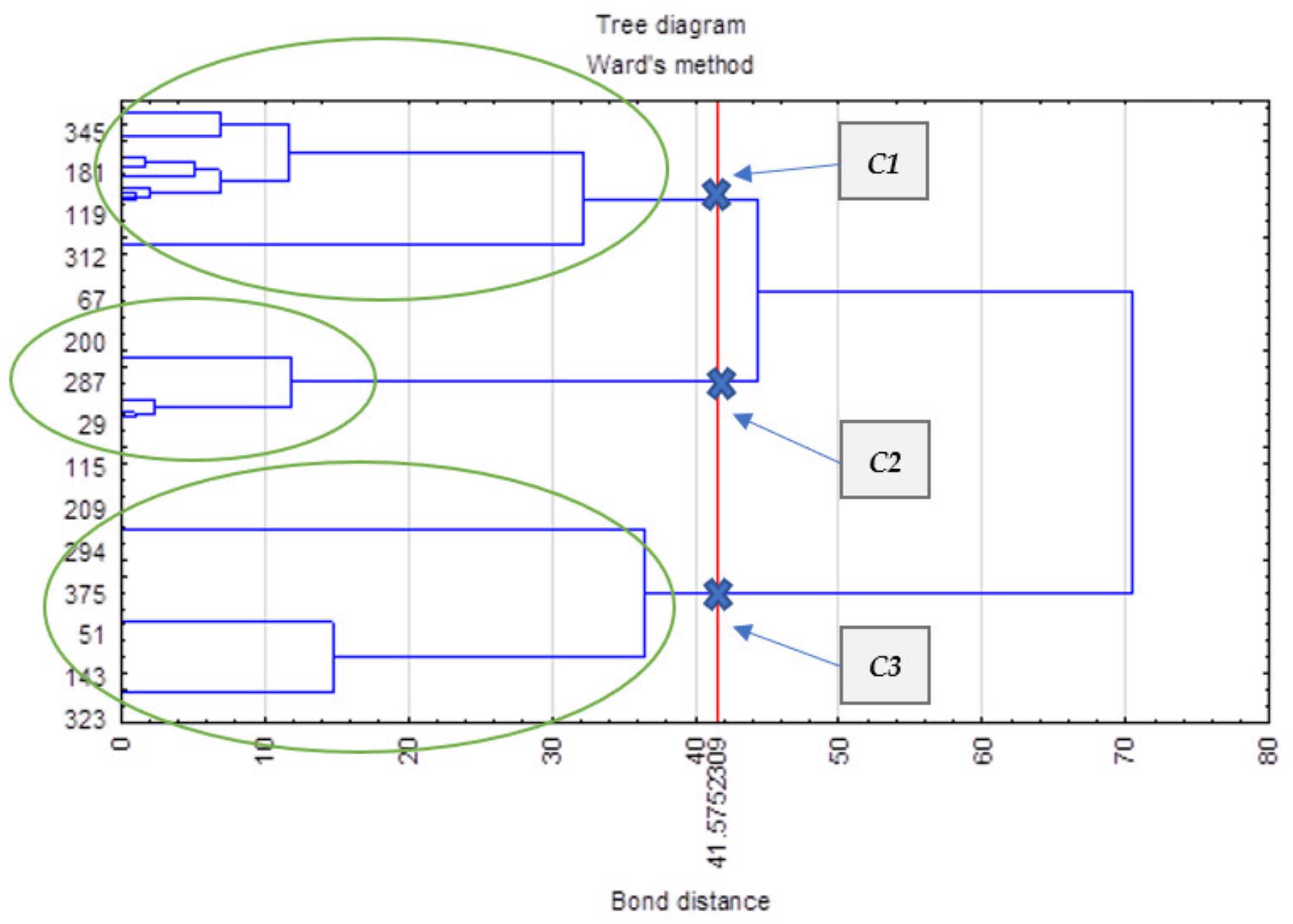
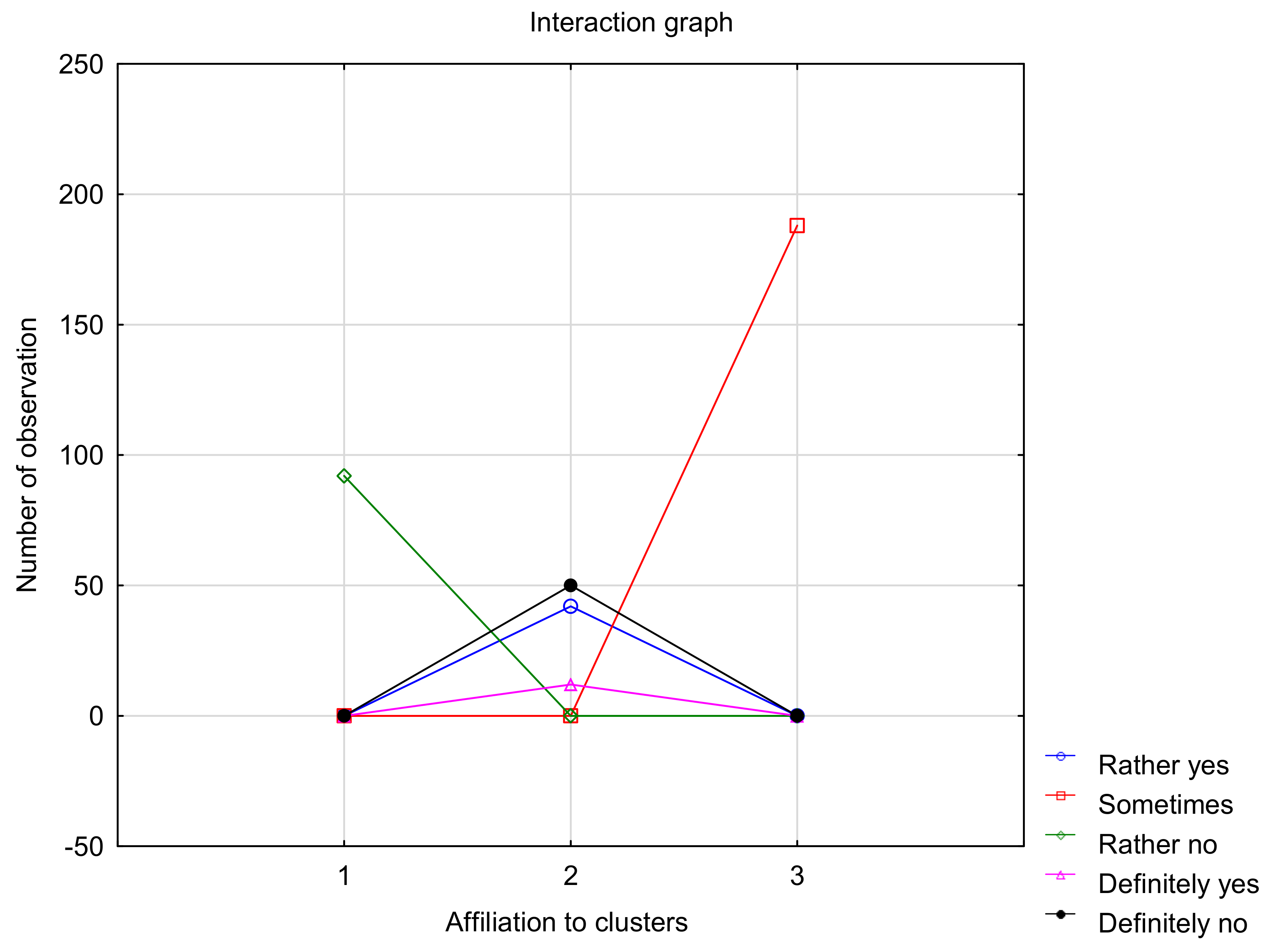
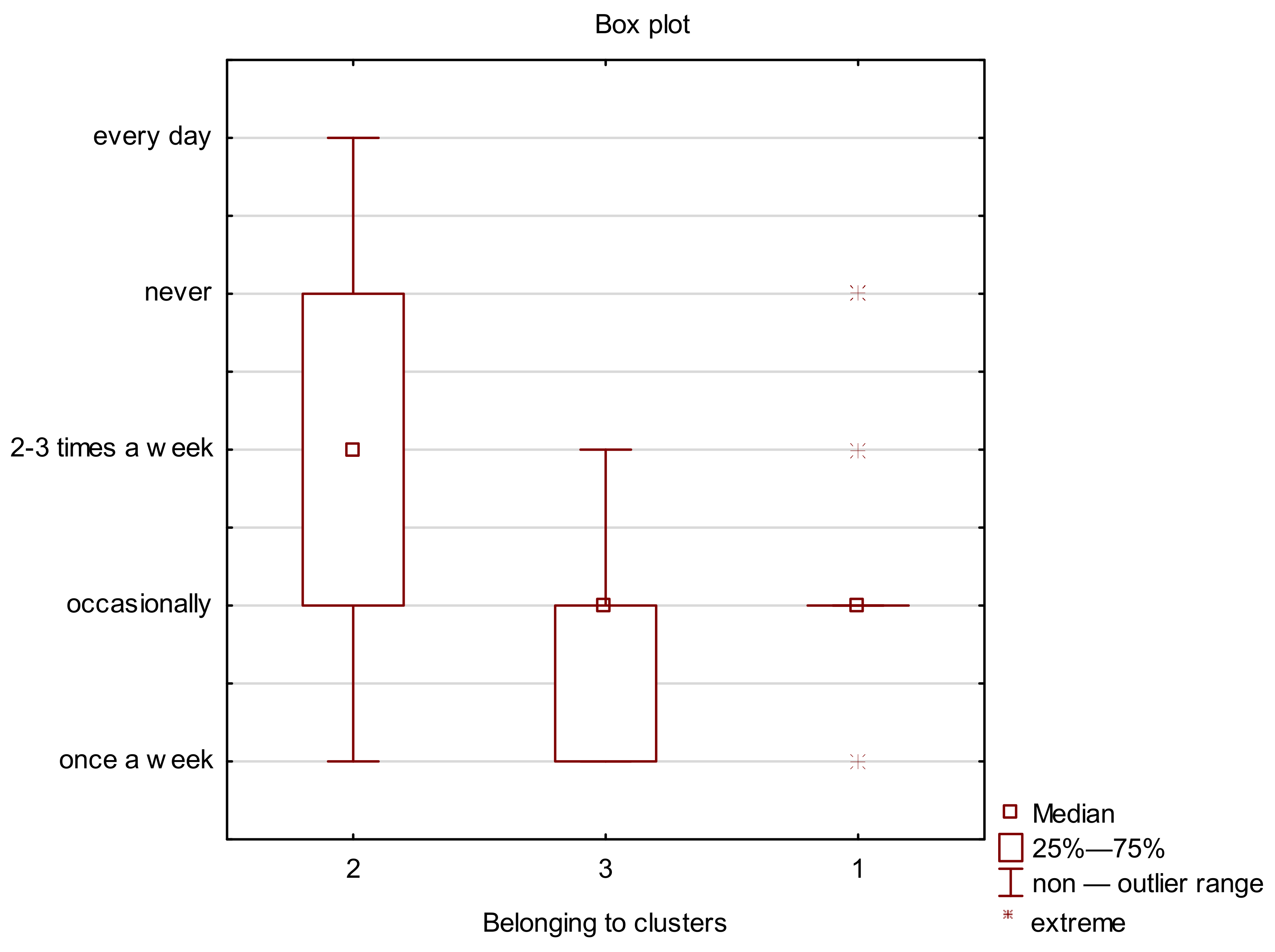
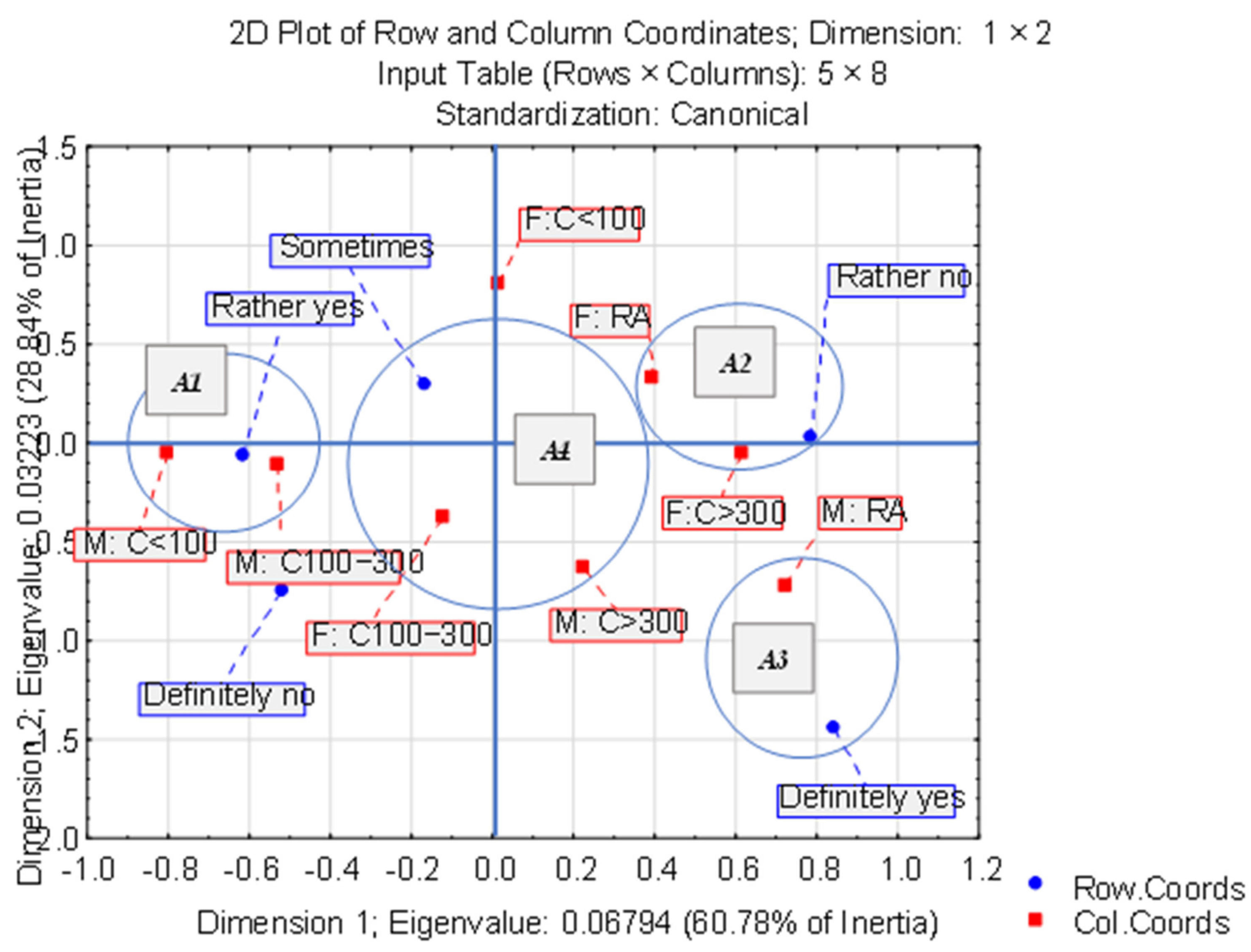
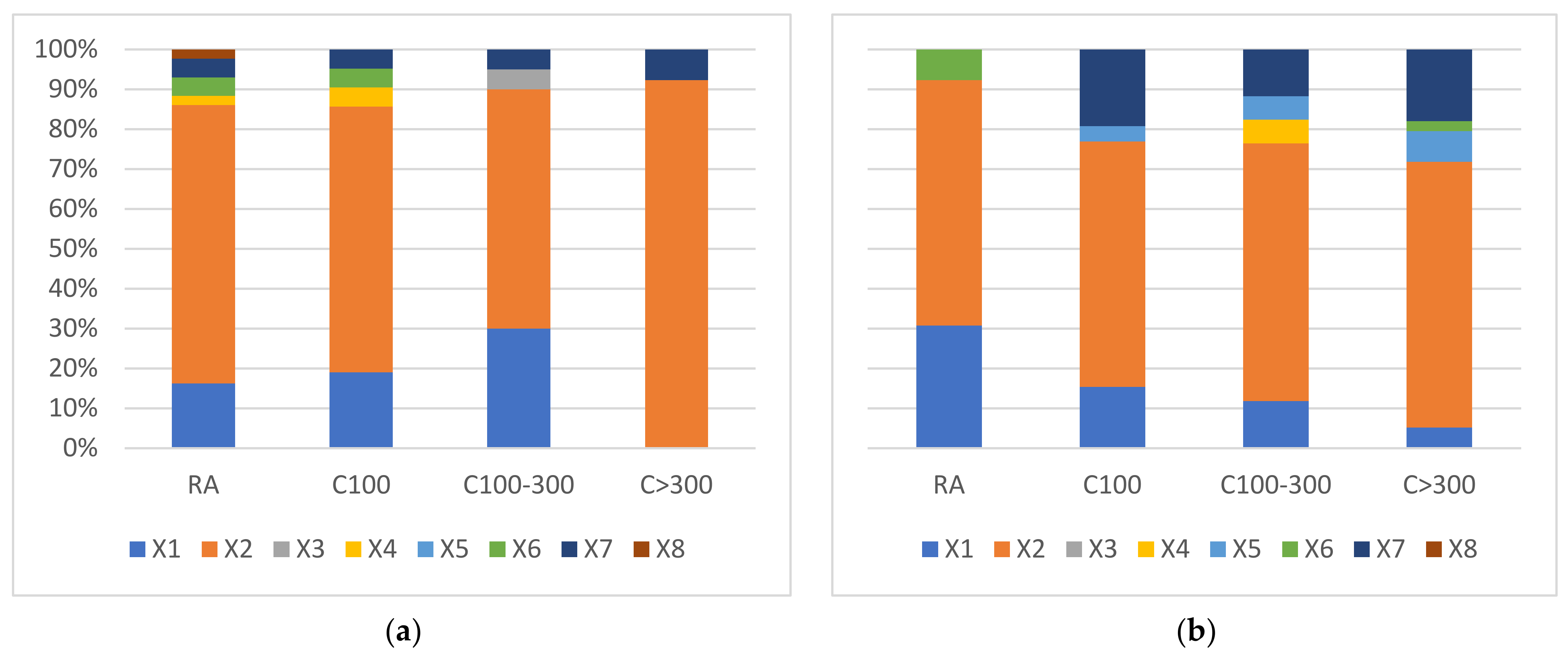
| Circular Economy  Linear Economy | Smarter product use and manufacture | Increasing Circularity | ||
| R0 | Refuse | Make product redundant by abandoning its function or by offering the same function with a radically different product | ||
| R1 | Rethink | Make product use more intensive (e.g., by sharing product) | ||
| R2 | Reduce | Increase efficiency in product manufacture or use by consuming fewer natural resources and materials | ||
| Extend lifespan of product and its parts | R3 | Reuse | Reuse by another consumer of discarded product which is still in good condition and fulfils its original function | |
| R4 | Repair | Repair and maintenance of defective product so it can be used with its original function | ||
| R5 | Refurbish | Restore an old product and bring it up to date | ||
| R6 | Remanufacture | Use parts of discarded product in a new product with the same function | ||
| R7 | Repurpose | Use discarded product or its parts in a new product with a different function | ||
| Useful application of materials | R8 | Recycle | Process materials to obtain the same (high grade) or lower (low grade) quality | |
| R9 | Recover | Incineration of material with energy recovery | ||
| Description | Characteristic |
|---|---|
| Research objectives |
|
| Research object | individual food consumers |
| Type of research | qualitative research |
| Research method and technique | online survey |
| Research tools | proprietary survey questionnaire posted on the Google platform |
| Selection of units for research | nonrandom, targeted |
| Sample selection criteria | individual food consumers, a group differentiated by sex, age, and place of residence |
| Sample size | 384 people |
| Spatial scope | Eastern Poland |
| Time range | January–June 2021 |
| Statistics | χ2 | df | p |
|---|---|---|---|
| Chi2 Pearson | 768.0000 | df = 8 | p = 0.0000 |
| Chi2 NW | 803.1489 | df = 8 | p = 0.0000 |
| Statistics | χ2 | df | p |
|---|---|---|---|
| Chi2 Pearson | 148.5032 | df = 8 | p = 0.0000 |
| Chi2 NW | 172.5425 | df = 8 | p = 0.0000 |
| Number of Dimensions | Eigenvalues and Inertia, Total Inertia = 0.11177, χ2 = 4435.0, df = 28, p = 0.00000 | ||||
|---|---|---|---|---|---|
| Singular Value | Eigenvalues | Percentage of Inertia | Cumulative Percentage | χ2 | |
| 1 | 0.260644 | 0.067935 | 60.77953 | 60.7795 | 2695.542 |
| 2 | 0.179531 | 0.032232 | 28.83645 | 89.6160 | 1278.882 |
| 3 | 0.104832 | 0.010990 | 9.83210 | 99.4481 | 436.049 |
| 4 | 0.024838 | 0.000617 | 0.55192 | 100.0000 | 24.477 |
Publisher’s Note: MDPI stays neutral with regard to jurisdictional claims in published maps and institutional affiliations. |
© 2022 by the authors. Licensee MDPI, Basel, Switzerland. This article is an open access article distributed under the terms and conditions of the Creative Commons Attribution (CC BY) license (https://creativecommons.org/licenses/by/4.0/).
Share and Cite
Dudziak, A.; Stoma, M.; Derkacz, A.J. Circular Economy in the Context of Food Losses and Waste. Sustainability 2022, 14, 10116. https://doi.org/10.3390/su141610116
Dudziak A, Stoma M, Derkacz AJ. Circular Economy in the Context of Food Losses and Waste. Sustainability. 2022; 14(16):10116. https://doi.org/10.3390/su141610116
Chicago/Turabian StyleDudziak, Agnieszka, Monika Stoma, and Arkadiusz J. Derkacz. 2022. "Circular Economy in the Context of Food Losses and Waste" Sustainability 14, no. 16: 10116. https://doi.org/10.3390/su141610116
APA StyleDudziak, A., Stoma, M., & Derkacz, A. J. (2022). Circular Economy in the Context of Food Losses and Waste. Sustainability, 14(16), 10116. https://doi.org/10.3390/su141610116







